|
|
| |
| |
 |
DARLINGe Progress
|
| |
|
|
In the 4th period DARLINGe project (DANUBE REGION LEADING GEOTHERMAL ENERGY) activities focused on pilot activities, where elements of the previously developed transnational tool-box have been tested, as well as on development of the Danube Region Geothermal Information Platform (DRGIP), the public knowledge-sharing and policy support portal of the project.
|
|
| |
 |
Testing of the tool-box modules on pilot areas
|
| |
|
Benchmark analysis
Benchmark analysis – as the first module of the tool-box – is based on the comparison of a set of independent indicators, which makes possible the comparison of quantitative, short and informative forward-taking results on the state of geothermal water management at different scales (pre-defined areas/regions/users), various technical characteristics of individual wells (objects), as well as the environmental and social impacts of thermal water use in a unique and harmonized way to identify possibilities for future improvements.
The basics of benchmarking methodology for geothermal use was adapted from a pre-existing scheme developed for managing the region around Lake Geneva in Switzerland and its first version was tested earlier in the T-JAM and TRANSENERGY projects. Some countries (e.g. Slovenia), have already integrated some of the indicators into their license granting processes, and the management of these geothermal aquifers has significantly improved since then.
The method has been further developed within DARLINGe, where new indicators were introduced and some of the previous indicators were modified according to the project area specifics and project goals.
The proposed benchmark indicators are described in details in deliverable D.6.3.1. “Manual on the use of the transnational tool-box”, completed in the previous project period and is available in the Library section of the project website.
|
|
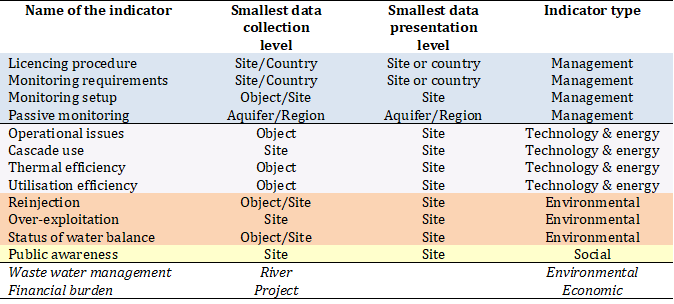 |
|
List of benchmarking indicators, data collection level and indicator type
|
| |
|
|
In Period 4 all partners put significant efforts on data collection for indicators calculations. This included detailed field inspections (e.g. checking the status of the wells – it turned out that many of the wells existing in databases are not functionning in reality, or even are abandonned), as well as interviews with users to get sufficient information on production.
The pilot areas are characterized by a large heterogeneity in terms of numbers of active wells, being subject of benchmark calculations. Where exceptionally high number of wells exist (e.g. the Hungarian part of the SRB-RO-HU pilot area with more than 140 wells), only expert judgement was done, whilst on the other territories of the pilot areas with an average of 5-50 wells, detailed calculations for each well have been performed.
Data collection has been completed by the end of 2018, and evaluation will be finalized in winter 2019.
|
| |
|
 |
|
Wellhead of an abandoned (left) and a properly maintained thermal water well (right) on the HU part of the SLO-HR-HU pilot area
|
| |
|
|
Classification of geothermal projects according to UNFC-2009 scheme
The second module of the tool-box refers to the application of an internationally accepted scheme: the Geothermal Specifications of the United Nations Framework Classification for Fossil Energy and Mineral Reserves and Resources (UNFC-2009). This scheme classifies a certain project according to 3 categories (E – Socio-economic viability; F – Project feasibility and G – Geological knowledge of the resources).
On the pilot areas partners selected geothermal projects to be classified representing various types of uses (space heating, balneology, cascade uses) at various stages of development (fully operational, to be expanded, etc.):
- Domaljevac (Federation of Bosnia and Herzegovina)
- Slobomir (Republic of Srpska, Bosnia and Herzegovina)
- Krapinske Toplice (Croatia)
- Szeged (Hungary)
- Lovrin (Romania)
- Bogatic (Serbia)
- Lendava and Moravske Toplice (Slovenia)
The population of the selected urban localities which can benefit from using geothermal energy largely varies, also the socio-economic viability and the geothermal projects’ feasibility. By comparing all selected projects in a standardized, globally-accepted classification system, pathways for project development will be identified and examples will be transferred to the neighbouring countries.
|
| |
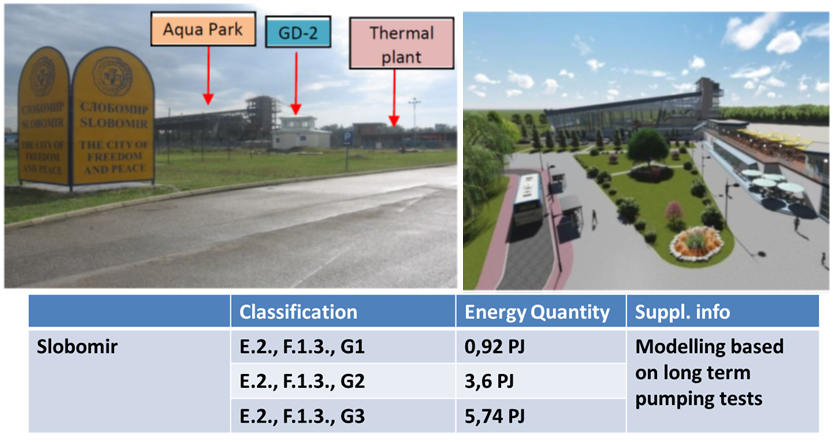 |
|
UNFC classification of Slobomir (Republic of Srpska): Thermal Plant and construction of Aqua Park in progress
|
|
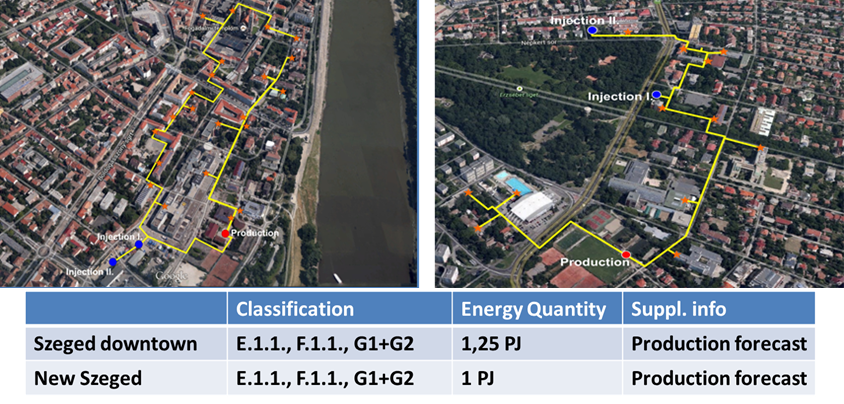 |
|
UNFC classification of 2 geothermal heating systems in Szeged, Hungary (left: Szeged downtown system; right: New Szeged system)
|
| |
|
|
Geological risk mitigation
|
| |
|
The third module of the tool-box addresses geological risk mitigation, as drilling the first exploratory well with high upfront costs coupled with high level of risk (coming from the low level of knowledge of the subsurface at this stage of project development) imposes one of the biggest barriers in geothermal developments. DARLINGe developed a novel approach of addressing risks of a geothermal project in a “retrospective way”, i.e. defining first the proofs of damages, than identifying the risk events that might have led to the given damages, followed by outlining the amending activities their conditions and timing to “repair” the damages, and finally describing the mitigation measures of the given risks.
|
|
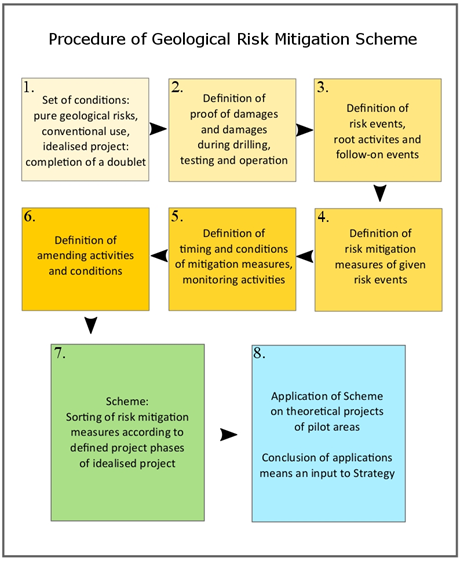 |
|
Concept of and procedure of creating of Geological Risk Mitigation Scheme in DARLINGe project
|
| |
|
|
This scheme is applied to certain project developments within the pilot areas, e.g. to assess the (transboundary) effects of drilling of new triplets during the expansion of the Szeged geothermal district heating system (SRB-RO-HU pilot area), or to study the regional impacts of a reinjection at Moravske Toplice, or implementation of a new geothermal heating project in Lenti close to the SLO-HU border (SLO-HR-HU pilot area).
Numerical hydrodynamic and heat transport models using FEFLOW software provide key information for these schemes, as they are able to quantify the effects of various future production scenarios (e.g. new wells drilled in different parts of the aquifer, new doublets for reinjection etc.). The modelling based on harmonized data can raise the attention on present and/or future conflicts and can reveal significant data shortages, as well as highlighting areas comprising untapped geothermal potentials. Further on, this type of modelling approach can establish the scientific basis for an integrated subsurface management, as a way forward for geosciences in the 21st century, where the diverse subsurface usages (e.g. geothermal, CH, CCS, energy storage etc.) and their co-impacts can be studied in a comprehensive manner.
The establishment of such numerical models started on the DARLINGe pilot areas and will be complemented in 2019.
|
|
 |
|
Example of harmonized input datasets for the numerical modelling in the SRB-RO-HU pilot area (left: thickness of Upper-Pannonian sequences “Basin Fill reservoir”, right: top of Pre-Cenozoic basement “Basement reservoir”)
|
| |
|
| |
 |
Development of the DRGIP Portal
|
|
The project consortium has made significant efforts in developing the Danube Region Geothermal Information Platform – the DRGIP portal. In addition to advancements on its main part, the web-map viewer where various thematic maps will be displayed in an interactive format, major progress was achieved in the construction of the so-called “thematic modules”, which will give demand-driven comprehensive overviews in the form of easy-to-understand charts, tables, short texts on selected topics.
These modules, which are under development, will be the following:
- benchmarking (graphical comparison of the benchmark indicators and a downloadable excel tool for further calculations)
- legislation (a simple colour-code based comparison of the results of the legislation questionnaires showing situation on licensing procedures and requirements in the partner countries)
- heat-demand (showing cities with district heating infrastructures with technical informations on the already existing power plants, as well as other settlements with potential for the installation of geothermal heating in the future)
- decision-tree (a comprehensive step-by-step guide for project developers)
- risk-mitigation (an excel-based tool for identifying risks and related amending and mitigating activities as well as their timing)
- economics (a simple assessment tool for comparing prices of fossil fuel based and geothermal heating)
- statistics overview (visualisation of various energy statistical data of the DARLINGe countries)
- publications (collection of relevant geothermal literature of the DARLINGe region with search functionalities)
- geothermal glossary (short explanation of the main technical terms used in geothermal context)
|
|
 |
| |
|
Layout of the benchmark module on the DRGIP portal - first draft
|
| |
|
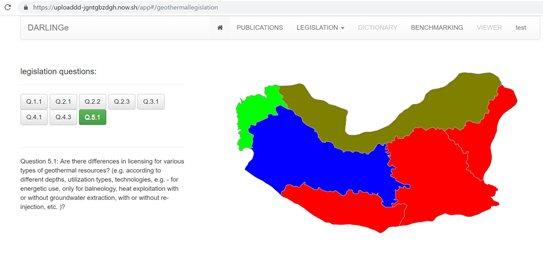 |
| |
|
Layout of the legislation module on the DRGIP portal - first draft
|
| |
|
| |
 |
DARLINGe dissemination
|
| |
|
|
The project was presented during its fourth period (July – December 2018) at:
- “World Multidisciplinary Earth Sciences Symposium” WMESS 2018, 3-7 September 2018, Prague, Czech Republic (2 oral presentations);
- Post-congress field trip of the “5th Slovenian Geological Congress, 6-8 October 2018: Geology, hydrogeology and geothermy of NE Slovenia and N Croatia” in the pilot area of the DARLINGe project;
- Article in Market Watch (on-line and printed magazine), October 2018;
- 7th Annual Forum of the EU Strategy for the Danube Region, 18-19 October 2018, Sofia, Bulgaria;
- Article in on-line magazine www.delo.si (8th November 2018).
|
|
| |
 |
Future activities
|
| |
|
In the first semester of 2019 DARLINGe team work will be targeted towards finalizing the project deliverables and organising in each project country a National Promotion Event, where the projects outputs will be presented to stakeholders. Trainings on the application of the DRGIP portal coupled with site visits will be also organized. Information and registration to these events will be published on the project website.
|
|
| |
 |
Contact
|
| |
|
|
|
|
| |
|
If you have received this newsletter, you have been included on one or more of the Danube Transnational Programme/projects postal mailing lists. We are committed to respect and protect the privacy of personal data collected. We regard your personal data as confidential information and will never communicate it to third parties. Your personal data are used mainly for the express purpose of receiving the newsletter. Your mailing details may also be used by the DTP and its projects for information and dissemination purposes strictly related to the programme and its projects. If you prefer not to receive more of this newsletter and your data not to be used for dissemination purposes, you can unsubscribe by sending a reply email.
|
|
|
|
|
|
